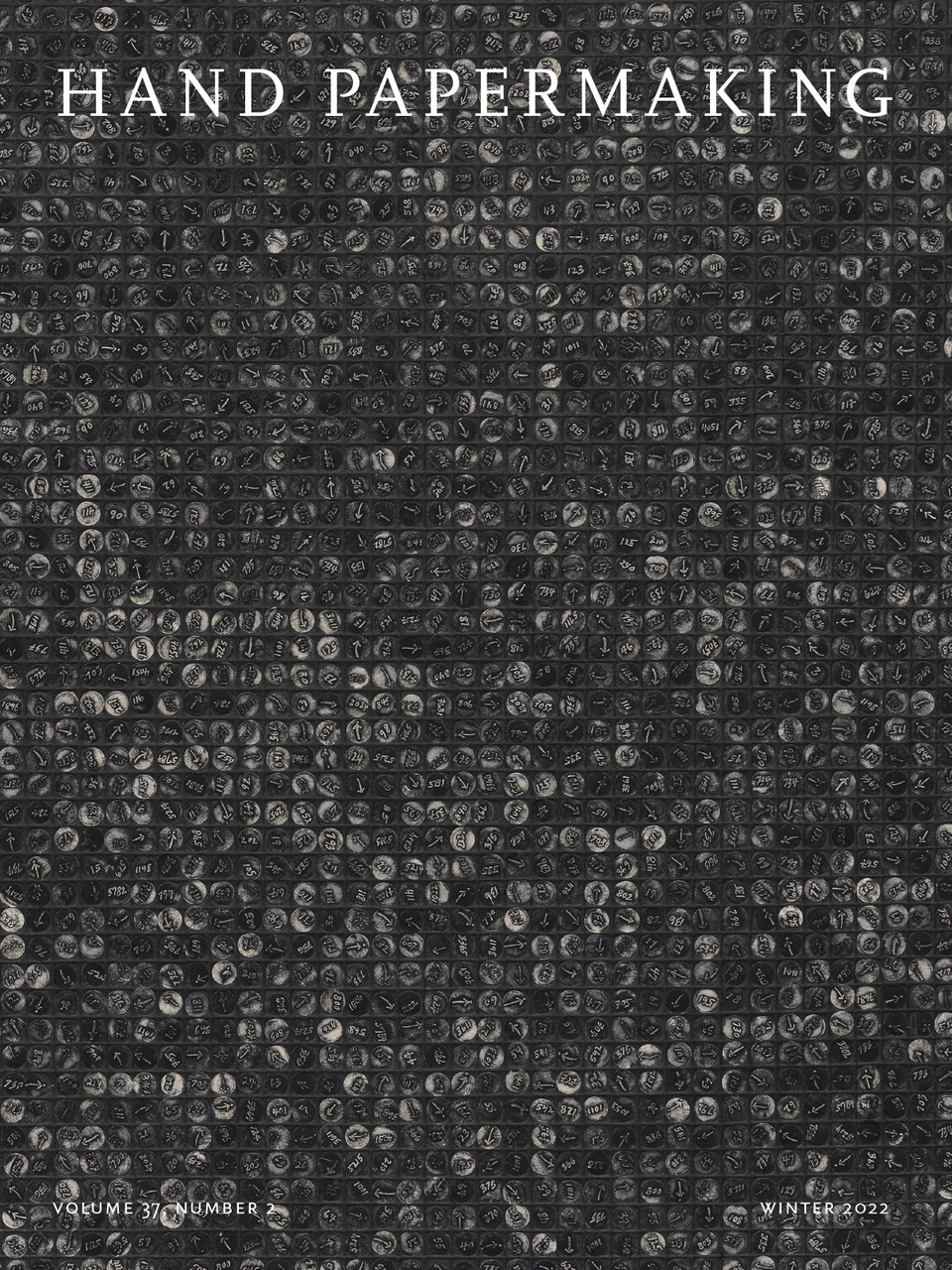While attending the University of Wisconsin–Madison—Derick as an MFA student and Kelsey as an undergraduate—we met in Mary Hark’s papermaking class. Our shared interest in repeat pattern design led to collaborative research using laser-cut stencils. Derick’s blowouts use a subtractive process of removing pulp left uncovered by the stencil, while Kelsey layers pulp painting with multiple stencils in an additive process.
Derick starts by drawing a repeat pattern on paper. He scans and translates the design into vector art using Adobe Illustrator. Kelsey builds her patterns directly in Illustrator, separating each color into individual layers so they may be cut separately. The vector files are compatible with laser-cutting software. We cut our stencils out of 1/16-to-⅛-inch-thick polyester sheeting, a plastic material that is safe to burn and dimensionally stable when wet.
For a blowout stencil, the negative space of the motif is cut away. Derick cuts the stencil to the exact size of the mould surface. The stencil protects the wet pulp underneath it, retaining the design in pulp as the rest of the sheet is washed away during the blowout process. For pulp painting, the positive space of the motif is cut away, creating stencils through which colored pulp can be directly applied to a base sheet. Kelsey cut stencils larger than the base sheet size, with registration marks to align with the edges of the base sheet.
Recycled cotton, raw flax, abaca pulp sheets, and combinations of the three all work well with laser-cut stencils. What is essential is to work with a highly beaten pulp with very short fibers that do not cling to the edges of the stencil. Four hours in a Hollander beater with the wheel height set at zero produces usable pulp.
For blowouts, Derick recommends a two-step process. Start by forming a batch of heavyweight, medium-beaten base sheets that are at least half cotton, pigmented with retention aid and sized internally using ½ tablespoon of alkyl ketene dimer emulsion per pound of dry fiber. Press the sheets and put them in a damp pack. For the blowout layer use a deckle box to form a thin sheet, also pigmented and sized internally. Once drained, remove the top of the deckle box and align the stencil to one side of the mould, then swing the stencil down so it falls in neat alignment onto the wet sheet. Begin spraying the stencil-covered wet sheet with a Fogg-it spray nozzle held facing straight down at a 90-degree angle to the mould, from about 12 inches above. Keep the nozzle moving across the entire mould in all directions until the pulp in the open areas of the stencil is washed away. (If the blowout sheet is too thick, there may be loss of detail.) Carefully lift the stencil from the mould by pulling up on one side; a little water may help the stencil release. Couch the pulp remaining on the mould onto a damp base sheet. Cover with a felt, and repeat this process. The couched blowouts can be pressed and dried normally, using a restraint drying system.
For the additive pulp-stenciling process, Kelsey suggests forming the base sheets concurrently with the stenciling process. To create Mom’s Quilt, Kelsey used a four-hour-beaten, 50/50 mix of recycled cotton and abaca for the base sheet and the pulp paints. To prepare the pulp paints, mix in 1 tablespoon of retention aid for each ½ pound of pulp. Add the pigments in small increments to slowly build color. Mix in a cup of formation aid per ½ pound of pulp and pour the pulp paints into squeeze bottles. The pulp may need further dilution with water or increased formation aid to encourage the pulp to flow like paint. Carefully register the stencil on top of a couched base sheet. Lightly run a finger along the surface of the stencil to create a better seal. Working from one side to another, apply pulp paint into the open areas of the stencil. It may be necessary to repeat this step to enhance the density of color. Allow the pulp-painted layer to sufficiently drain before removing the stencil by carefully lifting from the bottom corner and pulling slowly away from the sheet. With several overlapping stencils, this process can be repeated to build multiple layers of colored pulp in succession.
Laser cutting stencils has enabled each of us to build seamless patterns in handmade paper, complementing our art and craft with design. We have overcome the initial technical hurdles and are excited to experiment further with this rewarding hybrid of traditional papermaking and CNC technology.






